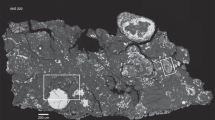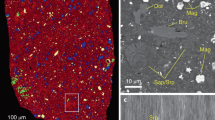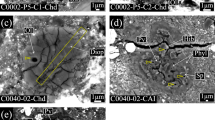Abstract
Meteorites originating from primitive C-type asteroids are composed of materials from the Sun’s protoplanetary disk, including up to a few per cent organic carbon. In contrast, some interplanetary dust particles and micrometeorites have much higher carbon contents, up to >90%, and are thought to originate from icy outer Solar System bodies and comets. Here we report an approximately 100-µm-diameter very carbon-rich clast, with highly primitive characteristics, in the matrix of a CR2 chondrite, LaPaz Icefield 02342. The clast may represent a cometary building block, largely unsampled in meteorite collections, that was captured by a C-type asteroid during the early stages of planet formation. The existence of this cometary microxenolith supports the idea of a radially inward transport of materials from the outer protoplanetary disk into the CR chondrite reservoir during the formation of planetesimals. Moreover, the H-isotopic composition of the clast is suggestive of a temporal evolution of organic isotopic compositions in the comet-forming region of the disk.
This is a preview of subscription content, access via your institution
Access options
Access Nature and 54 other Nature Portfolio journals
Get Nature+, our best-value online-access subscription
$29.99 / 30 days
cancel any time
Subscribe to this journal
Receive 12 digital issues and online access to articles
$119.00 per year
only $9.92 per issue
Buy this article
- Purchase on Springer Link
- Instant access to full article PDF
Prices may be subject to local taxes which are calculated during checkout







Similar content being viewed by others
Data availability
The data that support the plots within this paper and other findings of this study are available from the corresponding author upon reasonable request.
References
Kruijer, T. S., Burkhardt, C., Budde, G. & Kleine, T. Age of Jupiter inferred from the distinct genetics and formation times of meteorites. Proc. Natl Acad. Sci. USA 114, 6712–6716 (2017).
Weisberg, M. K., Prinz, M., Clayton, R. N. & Mayeda, T. K. The CR (Renazzo-type) carbonaceous chondrite group and its implications. Geochim. Cosmochim. Acta 57, 1567–1586 (1993).
Alexander, C. M.O’D., Fogel, M., Yabuta, H. & Cody, G. D. The origin and evolution of chondrites recorded in the elemental and isotopic compositions of their macromolecular organic matter. Geochim. Cosmochim. Acta 71, 4380–4403 (2007).
Nguyen, A. N., Nittler, L. R., Stadermann, F. J., Stroud, R. M. & Alexander, C. M. O’D. Coordinated analyses of presolar grains in the Allan Hills 77307 and Queen Elizabeth Range 99177 meteorites. Astrophys. J 719, 166–189 (2010).
Van Kooten, E. M. M. E. et al. Isotopic evidence for primordial molecular cloud material in metal-rich carbonaceous chondrites. Proc. Natl Acad. Sci. USA 113, 2011–2016 (2016).
Howard, K. T., Alexander, C. M. O’D., Schrader, D. L. & Dyl, K. A. Classification of hydrous meteorites (CR, CM and C2 ungrouped) by phyllosilicate fraction: PSD-XRD modal mineralogy and planetesimal environments. Geochim. Cosmochim. Acta 149, 206–222 (2015).
Schramm, L. S., Brownlee, D. E. & Wheelock, M. M. Major element composition of stratospheric micrometeorites. Meteoritics 24, 99–112 (1989).
Thomas, K. L., Blanford, G. E., Keller, L. P., Klock, W. & McKay, D. S. Carbon abundance and silicate mineralogy of anhydrous interplanetary dust particles. Geochim. Cosmochim. Acta 57, 1551–1566 (1993).
Duprat, J. et al. Extreme deuterium excesses in ultracarbonaceous micrometeorites from central Antarctic snow. Science 328, 742–745 (2010).
Dartois, E. et al. UltraCarbonaceous Antarctic micrometeorites, probing the Solar System beyond the nitrogen snow-line. Icarus 224, 243–252 (2013).
Dartois, E. et al. Dome C ultracarbonaceous Antarctic micrometeorites: infrared and Raman fingerprints. Astron. Astrophys. 609, A65 (2018).
Trigo-Rodríguez, J. M. et al. Evidence for extended aqueous alteration in CR carbonaceous chondrites. Lunar Planet. Sci. 44, abstr. 1929 (2013).
Wasson, J. T. & Rubin, A. E. Composition of matrix in the CR chondrite LAP 02342. Geochim. Cosmochim. Acta 73, 1436–1460 (2009).
Trigo-Rodriguez, J. M. & Blum, J. Tensile strength as an indicator of the degree of primitiveness of undifferentiated bodies. Planet. Space Sci. 57, 243–249 (2009).
Nittler, L. R. et al. High abundances of presolar grains and 15N-rich organic matter in CO3.0 chondrite dominion range 08006. Geochim. Cosmochim. Acta 226, 107–131 (2018).
Floss, C. & Haenecour, P. Presolar silicate grains: abundances, isotopic and elemental compositions, and the effects of secondary processing. Geochem. J. 50, 3–25 (2016).
Davidson, J. et al. Abundances of presolar silicon carbide grains in primitive meteorites determined by NanoSIMS. Geochim. Cosmochim. Acta 139, 248–266 (2014).
Sakamoto, N. et al. Remnants of the early Solar System water enriched in heavy oxygen isotopes. Science 317, 231–233 (2007).
Starkey, N. A., Franchi, I. A. & Lee, M. R. Isotopic diversity in interplanetary dust particles and preservation of extreme 16O-depletion. Geochim. Cosmochim. Acta 142, 115–131 (2014).
Busemann, H. et al. Interstellar chemistry recorded in organic matter from primitive meteorites. Science 312, 727–730 (2006).
Urquhart, S. G. & Ade, H. Trends in the carbonyl core (C 1s, O 1s) → π*C=O transition in the near-edge X-ray absorption fine structure spectra of organic molecules. J. Phys. Chem. B 106, 8531–8538 (2002).
Alexander, C. M. O’D., Cody, G. D., Gregorio, B. T. D., Nittler, L. R. & Stroud, R. M. The nature, origin and modification of insoluble organic matter in chondrites, the major source of Earth’s C and N. Chem. Erde 77, 227–256 (2017).
Keller, L. P. & Messenger, S. On the origins of GEMS grains. Geochim. Cosmochim. Acta 75, 5336–5365 (2011).
Le Guillou, C., Changela, H. G. & Brearley, A. J. Widespread oxidized and hydrated amorphous silicates in CR chondrites matrices: implications for alteration conditions and H2 degassing of asteroids. Earth Planet. Sci. Lett. 420, 162–173 (2015).
Abreu, N. M. Why is it so difficult to classify Renazzo-type (CR) carbonaceous chondrites? Implications from TEM observations of matrices for the sequences of aqueous alteration. Geochim. Cosmochim. Acta 194, 91–122 (2016).
Bradley, J. P. et al. An infrared spectral match between GEMS and interstellar grains. Science 285, 1716–1718 (1999).
Yabuta, H. et al. Formation of an ultracarbonaceous Antarctic micrometeorite through minimal aqueous alteration in a small porous icy body. Geochim. Cosmochim. Acta 214, 172–190 (2017).
Nakamura-Messenger, K., Clemett, S. J., Messenger, S. & Keller, L. P. Experimental aqueous alteration of cometary dust. Meteorit. Planet. Sci. 46, 843–856 (2011).
Leroux, H., Cuvillier, P., Zanda, B. & Hewins, R. H. GEMS-like material in the matrix of the Paris meteorite and the early stages of alteration of CM chondrites. Geochim. Cosmochim. Acta 170, 247–265 (2015).
Alexander, C. M. O’D. et al. The provenances of asteroids, and their contributions to the volatile inventories of the terrestrial planets. Science 337, 721–723 (2012).
Matrajt, G., Messenger, S., Brownlee, D. & Joswiak, D. Diverse forms of primordial organic matter identified in interplanetary dust particles. Meteorit. Planet. Sci. 47, 525–549 (2012).
Floss, C., Noguchi, T. & Yada, T. Hydrogen and nitrogen imaging of Ultra-Carbonaceous Antarctic Micrometeorite TT54B397. Meteorit. Planet. Sci. Suppl. 76, 5230 (2013).
Trigo-Rodríguez, J. M. & Llorca, J. On the sodium overabundance in cometary meteoroids. Adv. Space Res. 39, 517–525 (2007).
Trigo-Rodríguez, J. M., Llorca, J. & Fabregat, J. Chemical abundances determined from meteor spectra—II. Evidence for enlarged sodium abundances in meteoroids. Mon. Not. R. Astron. Soc. 348, 802–810 (2004).
McKeegan, K. D. et al. The oxygen isotopic composition of the Sun inferred from captured solar wind. Science 332, 1528–1532 (2011).
Lyons, J. R. & Young, E. D. CO self-shielding as the origin of oxygen isotope anomalies in the early solar nebula. Nature 435, 317–320 (2005).
Yurimoto, H. & Kuramoto, K. Molecular cloud origin for the oxygen isotope heterogeneity in the Solar System. Science 305, 1763–1766 (2004).
Labidi, J., Farquhar, J., Alexander, C. M. O’D., Eldridge, D. L. & Oduro, H. Mass independent sulfur isotope signatures in CMs: implications for sulfur chemistry in the early Solar System. Geochim. Cosmochim. Acta 196, 326–350 (2017).
Bharmoria, P., Gehlot, P. S., Gupta, H. & Kumar, A. Temperature-dependent solubility transition of Na2SO4 in water and the effect of NaCl therein: solution structures and salt water dynamics. J. Phys. Chem. B 118, 12734–12742 (2014).
Alexander, C. M. O’D., Bowden, R., Fogel, M. L. & Howard, K. T. Carbonate abundances and isotopic compositions in chondrites. Meteorit. Planet. Sci. 50, 810–833 (2015).
Jilly-Rehak, C. E., Huss, G. R., Nagashima, K. & Schrader, D. L. Low-temperature aqueous alteration on the CR chondrite parent body: implications from in situ oxygen-isotope analyses. Geochim. Cosmochim. Acta 222, 230–252 (2018).
Augé, B. et al. Irradiation of nitrogen-rich ices by swift heavy ions: clues for the formation of ultracarbonaceous micrometeorites. Astron. Astrophys. 592, A99 (2016).
Ciesla, F. J. & Sandford, S. A. Organic synthesis via irradiation and warming of ice grains in the solar nebula. Science 336, 452–454 (2012).
Sugiura, N. & Fujiya, W. Correlated accretion ages and ɛ54Cr of meteorite parent bodies and the evolution of the solar nebula. Meteorit. Planet. Sci. 49, 772–787 (2014).
Brownlee, D. et al. Comet 81P/Wild 2 under a microscope. Science 314, 1711–1716 (2006).
Schrader, D. L. et al. The retention of dust in protoplanetary disks: evidence from agglomeratic olivine chondrules from the outer Solar System. Geochim. Cosmochim. Acta 223, 405–421 (2018).
Briani, G., Morbidelli, A., Gounelle, M. & Nesvorný, D. Evidence for an asteroid–comet continuum from simulations of carbonaceous microxenolith dynamical evolution. Meteorit. Planet. Sci. 46, 1863–1877 (2011).
Slodzian, G., Hillion, F., Stadermann, F. J. & Zinner, E. QSA influences on isotopic ratio measurements. Appl. Surf. Sci. 231–232, 874–877 (2004).
Nittler, L. R., Alexander, C. M. O’D., Gao, X., Walker, R. M. & Zinner, E. Stellar sapphires: the properties and origins of presolar Al2O3 in meteorites. Astrophys. J. 483, 475–495 (1997).
Hoppe, P., Leitner, J. & Kodolányi, J. The stardust abundance in the local interstellar cloud at the birth of the Solar System. Nat. Astron. 1, 617–620 (2017).
Bassim, N. D. et al. Minimizing damage during FIB sample preparation of soft materials. J. Microsc. 245, 288–301 (2012).
Acknowledgements
J.M.T.-R. and C.E.M.-C. acknowledge funding support from Spanish grants AYA 2011-26522 and AYA 2015-67175-P. C.E.M.-C. and S.T. participated in this study in the frame of a PhD in Physics at the Autonomous University of Barcelona. L.R.N., C.M.O’D.A., R.M.S. and B.T.D. acknowledge funding support from NASA grants NNX10AI63G and NNH16AC42I. This research used resources of the Advanced Light Source, which is a DOE Office of Science User Facility under contract no. DE-AC02-05CH11231. We thank H. Yabuta and J. Duprat for helpful comments that improved this paper.
Author information
Authors and Affiliations
Contributions
J.M.T.-R. and C.E.M.-C. identified the C-rich clast and brought it to the attention of the other authors. J.M.T.-R., L.R.N. and R.M.S. designed the study. All authors participated in data acquisition and analysis. L.R.N. and J.M.T.-R. wrote the paper with substantial input from other authors.
Corresponding author
Ethics declarations
Competing interests
The authors declare no competing interests.
Additional information
Journal peer review information: Nature Astronomy thanks Jean Duprat, Hikaru Yabuta and the other anonymous reviewers for their contribution to the peer review of this work.
Publisher’s note: Springer Nature remains neutral with regard to jurisdictional claims in published maps and institutional affiliations.
Supplementary information
Supplementary Information
Supplementary Figures 1–7, Supplementary Tables 1–7
Rights and permissions
About this article
Cite this article
Nittler, L.R., Stroud, R.M., Trigo-Rodríguez, J.M. et al. A cometary building block in a primitive asteroidal meteorite. Nat Astron 3, 659–666 (2019). https://doi.org/10.1038/s41550-019-0737-8
Received:
Accepted:
Published:
Issue Date:
DOI: https://doi.org/10.1038/s41550-019-0737-8
This article is cited by
-
The origin and fate of volatile elements on Earth revisited in light of noble gas data obtained from comet 67P/Churyumov-Gerasimenko
Scientific Reports (2020)
-
Concepts of the Small Body Sample Return Missions - the 1st 10 Million Year Evolution of the Solar System
Space Science Reviews (2020)
-
GEMS and the devil in their details
Nature Astronomy (2019)
-
Reply to: GEMS and the devil in their details
Nature Astronomy (2019)



